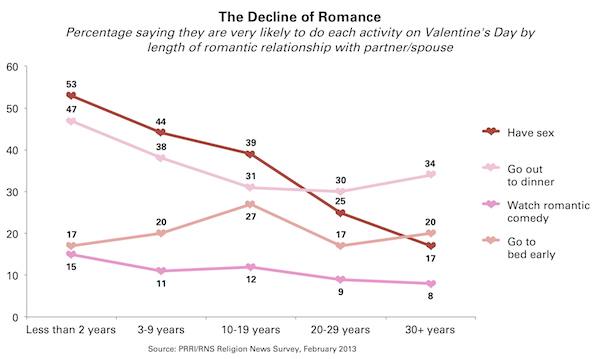Are relationships like a fine wine, getting better with each passing year? Or do love and romance fade with age? To provide some answers to these tough questions, we took a look at the 2013 PRRI/RNS Religion News Survey to see how couples at various stages in their relationship—from less than two years to over 30 years—celebrate Valentine’s Day.
Here are the four important facts you need to know:

(1) Not tonight, I have a headache… You may have already guessed it, but as the length of the relationship increases, the expectations about sex on Valentine’s Day dwindles. Only about 1-in-6 (17 percent) Americans in relationships of 30+ years report they are very likely to have sex on Valentine’s Day, compared to over half (53 percent) of Americans in relationships less than two years.
(2) Forget the popcorn. We found that sex isn’t the only Valentine’s Day activity that decreases over time. As a relationship matures, we see a (near) steady decline in the percentage of Americans who report they’re likely to be watching a romantic comedy on February 14. Only 25 percent of Americans in relationships of 30+ years say they are very or somewhat likely to curl up and watch a rom-com, compared to nearly half of Americans (46 percent) in relationships less than two years who say they are very or somewhat likely.
(3) Table for two? When it comes to the likelihood of going out to dinner to celebrate Valentine’s Day, younger couples, for the most part, take the cake yet again. While nearly half (47 percent) of Americans in relationships less than two years are very likely to go out to dinner, this number drops to 38 percent for those in relationships of 3-9 years, and then again to 31 percent for those in relationships of 10-19 years. This downward shift rebounds slightly amongst couples in relationships 30+ years, with 34 percent reporting they are very likely to go out to dinner.
(4) Let’s call it an early night! The one Valentine’s Day activity that doesn’t seem to be impacted by the length of a couple’s relationship is bedtime. Americans in relationships of less than two years (17 percent), 3-9 years (20 percent), 20-29 years (17 percent), and 30+ years (20 percent) are all about as likely to report hitting the hay early. The only outlier? Americans in relationships 10-19 years. At 27 percent, they’re the most likely to call it an early night. This may be because these couples are at the prime age for having young children—bad for any hope of romance of Valentine’s Day, but good for exhausting you.